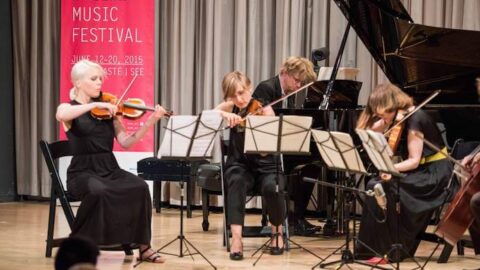Sounds that gallivanted, catapulted, zigzagged, and, eventually, tangoed: granted “free license” to program a concert of Finnish music, the Chelsea Music Festival’s 2015 ensemble-in-residence Avanti! decided to showcase a range of musical moods and ideas. At their June 15, 2015 concert at Scandinavia House, the versatile ensemble contrasted recent music by Finnish composers with the traditional sounds of Finnish dances. Unlike the more predictable pairing with Sibelius, the resulting performances allowed for insight into the non-classical heritage of these composers, as well as lending the listeners an element of capriciousness–or at the very least, unconventionality–that is usually so sorely lacking from self-described “portrait” concerts.
Most obvious in this display was Jukka Tiensuu’s Tango Lunaire (1985), unsurprisingly scored for Pierrot ensemble. Tiensuu, whose website describes him as “a universal musician,” has been influenced by IRCAM, Baroque music, and aleatoricism, but for years has refused to provide program notes for his compositions. His music seems to inhabit its own bizarre sound world, effortlessly merging different genres in the crystallization of his own unclassifiable voice. Unlike the proceeding pieces by Ilari Kaila, Veli-Matti Puumala, and Kaija Saariaho, which seemed to glide from one dreamy instant to another, this music was full of motion from the beginning. Pianist Jouko Laivuor clanged out clusters stretching from his wrist to his elbow while the other musicians flounced through a Scandinavian-tinged tango (or tango-tinged Scandinavian piece). All of this flurry and movement seemed to be leading, ironically enough, to the final indecisive chord. Falling as it did in the center of the evening, Tango Lunaire managed to tie together the “new,” exploratory sounds on the program with the more traditional dance music.

The pieces by Kaila, Puumala, and Saariaho were less kinetic and more ethereal, containing vaguely shifting, sometimes disjointed vertical moments that delicately called forth Finnish landscapes and occasionally found themselves wandering into quixotic beauty. In Kaila’s The Bells Bow Down (2006), the instruments–string quartet plus piano–slid in and out of ideas that ranged from shrill trickling chords to gallivanting piano melodies, creating dissonances not in the layers of tones but in the disjunct from one moment to the next between textures and dynamics. Puumala’s Apostrophe (2005), for string quartet and percussion, consisted of clearer and more consonant colors that seemed to materialize in angles as acute as those of the light across the sky in Finland. During the first half of the piece, solo violinist Eriikka Maalismaa catapulted slews of notes that showered across feeble chords from the other strings and occasional startling beats from Ayano Kataoka on the drums. After a pause, the string players strummed and tapped rhythms and uneasy chords across the strings and, eventually, the bodies of their instruments, before a total diminishment into silence. Just as these cute ripples of sounds contrasted with the earlier cascades, the soft gong strokes from Kataoka contrasted with the harsh pummels of before. The work fairly accurately mimicked an apostrophized word: it made sense as one experienced it in the moment, but not so much upon closer reflection of the individual parts falling on either side of the apostrophe. Finally, Saariaho’s Cendres (1998) for flute, cello, and piano explored different possibilities and combinations of pitch, articulation, rhythm, and timbre. Throughout the piece, Saariaho allows each instrument to expand outwards into the extremes of its own distinct palette (hissing into the flute, jagged sawing on the cello), while at other times winnowing them down into homogeneous waves of sound.

The second half of the concert began with the third movement of Aulis Sallinen’s Piano Quintet no. 2 (2006), a sort of elongation of initially lopsided, limping phrases into a sad yet hopeful conversation of grey and quiet colors. The mood was immediately lightened by Markku Lepistö’s accordion solos. His performance of three popular Finnish dance tunes that jaunted and traipsed and drawled was nothing less than delightful. The final work on the program was also the largest: Magnus Lindberg’s Corrente China (2000) for a much larger version of Avanti!, joined by conductor Ken-David Masur. The piece continually split itself into jigsaw puzzle pieces of scattered jumbles of sounds and then fell back together into drowsy wholeness.
After the final strained chord, the chamber orchestra was joined by Lepistö and a vocalist for a string of Finnish tangos. The unsettling atmosphere of Lindberg’s sound world quickly evaporated as the audience was treated to a vibrant, infectious “bonus” performance, reminding us that new music concerts don’t always have to take themselves so seriously.
























